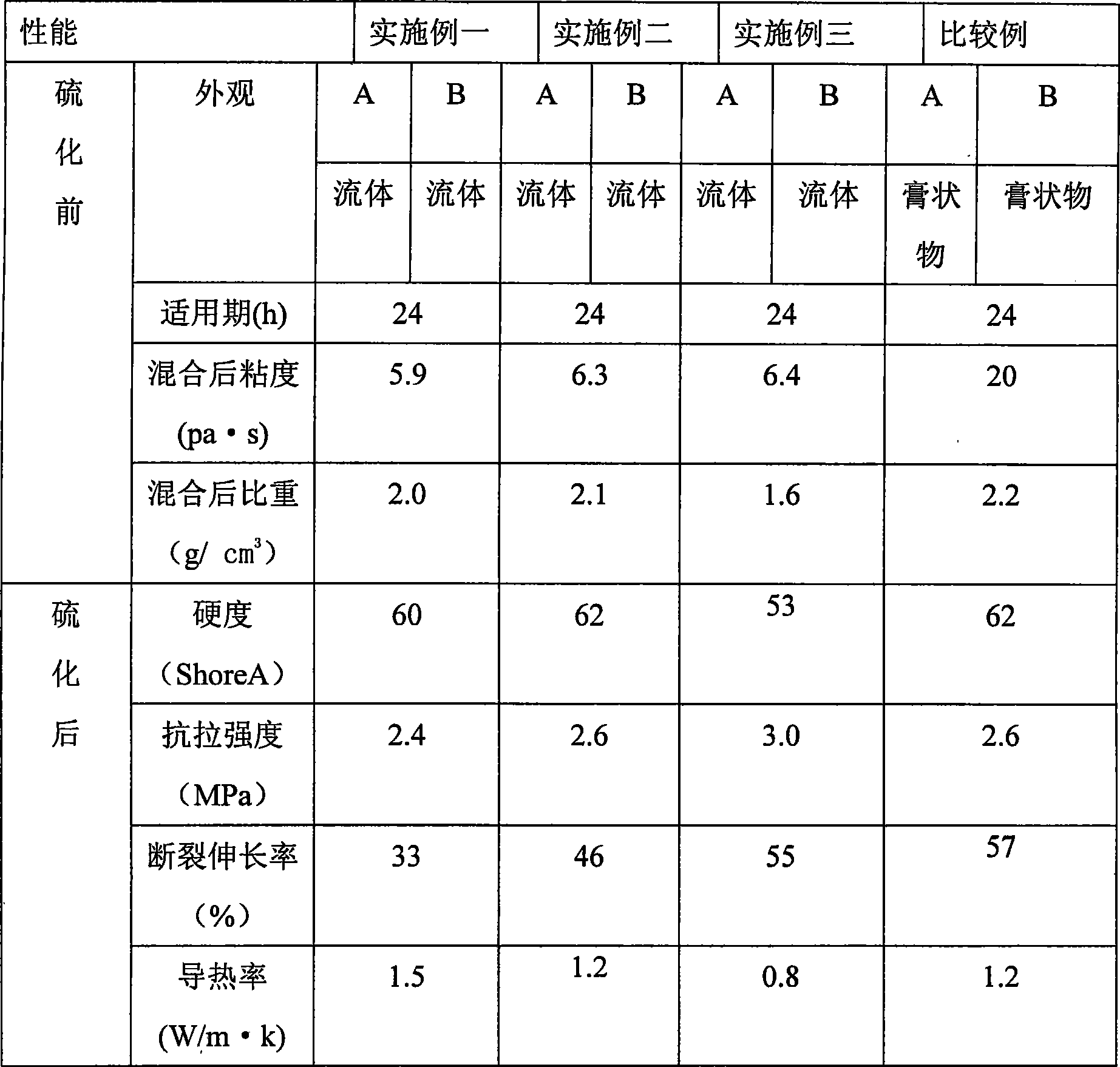Addition type heat conducting silicon rubber and manufacturing method thereof
A thermal conductive silicone rubber and addition molding technology, applied in the field of polymer materials, can solve problems such as the inability to meet the requirements of the rapid development of the electronics industry, the inability to cure and cure speed, and the lack of flow properties, achieving excellent thermal conductivity and outstanding flow properties. , conducive to the effect of potting
- Summary
- Abstract
- Description
- Claims
- Application Information
AI Technical Summary
Problems solved by technology
Method used
Image
Examples
Embodiment 1
[0042] Example 1: Add 100 parts by mass of vinyl silicone oil with a viscosity of 400 mpa·s at a temperature of 25°C, 450 parts by mass of aluminum oxide, and 50 parts by mass of silicon nitride into a vacuum kneader, and at a temperature of 150°C, a vacuum degree of 0.06 MPa, dehydration and blending for 200 minutes to obtain the base material. Add 1 mass part of hydrogen-containing silicone oil with a hydrogen content of 0.5%, 0.01 mass part of 2-methyl-3-butynyl-2 alcohol, and 3 mass parts of octamethylcyclotetrasiloxane into a mixer and 100 mass parts base Stir and mix the materials for 30 minutes to obtain component A; add 0.25 parts by mass of alcohol solution of chloroplatinic acid and 3 parts by mass of octamethylcyclotetrasiloxane to a mixer and stir and mix with 100 parts by mass of the base material for 30 minutes to obtain component B ; After taking equal mass of component A and component B and mixing evenly, degassing at a vacuum degree of 0.06MPa for 3 minutes to...
Embodiment 2
[0043] Example 2: Add 100 parts by mass of vinyl silicone oil with a viscosity of 1000 mpa·s at a temperature of 25°C, 350 parts by mass of aluminum oxide, and 50 parts by mass of silicon carbide into a vacuum kneader. MPa, dehydration and blending for 120 minutes to obtain the base material. Add 2 parts by mass of hydrogen-containing silicone oil with a hydrogen content of 1%, 0.06 parts by mass of methyltris(methylbutynyloxy)silane, and 5 parts by mass of tetramethyltetravinylcyclotetrasiloxane into a mixer for neutralization 100 parts by mass of the base material were stirred and mixed for 30 minutes to obtain component A; 0.5 parts by mass of vinylsiloxane chelate of chloroplatinic acid and 5 parts by mass of tetramethyltetravinylcyclotetrasiloxane were added to the mixer and 100 parts by mass The mass parts of the base material were stirred and mixed for 30 minutes to obtain the B component; after taking the equal mass of the A component and the B component and mixing the...
Embodiment 3
[0044] Example 3: Add 100 parts by mass of vinyl silicone oil with a viscosity of 3000mpa·s at 25°C, 180 parts by mass of aluminum oxide, and 20 parts by mass of silicon carbide into a vacuum kneader. Mix for 30 minutes to obtain a base. Add 2 parts by mass of hydrogen-containing silicone oil with a hydrogen content of 0.75%, 0.03 parts by mass of methyltris(methylbutynyloxy)silane, and 10 parts by mass of hexamethyldisiloxane into a mixer to neutralize 100 parts by mass of base The material was stirred and mixed for 15 minutes to obtain component A; 0.75 parts by mass of vinylsiloxane chelate of chloroplatinic acid and 10 parts by mass of hexamethyldisiloxane were added to a mixer and stirred and mixed with 100 parts of base material for 40 Component B can be obtained in minutes; after mixing components A and B of equal mass, degassing at a vacuum degree of 0.09MPa for 10 minutes to obtain addition-type thermally conductive silicone rubber, the product performance test result...
PUM
| Property | Measurement | Unit |
|---|---|---|
| viscosity | aaaaa | aaaaa |
| viscosity | aaaaa | aaaaa |
| viscosity | aaaaa | aaaaa |
Abstract
Description
Claims
Application Information
 Login to View More
Login to View More - R&D
- Intellectual Property
- Life Sciences
- Materials
- Tech Scout
- Unparalleled Data Quality
- Higher Quality Content
- 60% Fewer Hallucinations
Browse by: Latest US Patents, China's latest patents, Technical Efficacy Thesaurus, Application Domain, Technology Topic, Popular Technical Reports.
© 2025 PatSnap. All rights reserved.Legal|Privacy policy|Modern Slavery Act Transparency Statement|Sitemap|About US| Contact US: help@patsnap.com

